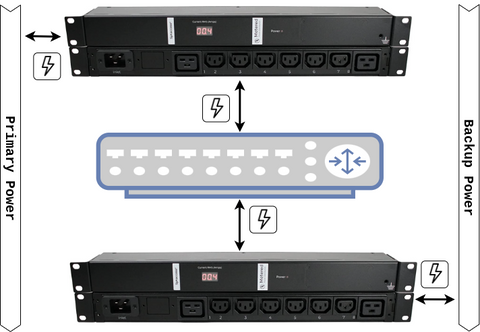Ensuring reliable power redundant scheme is a critical aspect of running a successful server rack. This blog offers a comprehensive overview of best practices and practical tips to ensure efficient power distribution in your server rack. Whether you're an IT manager, Datacenter Operator, or simply seeking to improve your power redundancy setup, this guide provides valuable insights and information that you won't want to miss.
In This Guide
This guide walks you through the different components used in a power redundant server or IT rack. A typical setup includes the power source, the rack PDUs, and the equipment's redundant internal power supplies.
We briefly discuss what a power supply is and how the load is shared between the redundant power supplies. Knowing how the load is shared will guide you on how to budget power and avoid overloading the PDU. For devices without redundant power supply, we present an alternative solution.
Finally, we explore different rack PDU options to safely distribute and manage power to critical equipment. By the end of this guide, you should have the tools and information you need to carefully plan your next server's power redundant scheme.
Why Power Redundancy is Crucial
Power redundancy is a critical aspect of maintaining a reliable and efficient IT and server rack infrastructure. It is a system design that provides multiple sources of power to a single device or system, so that if one power source fails, the other can take over and keep the device or system running.
One of the most obvious benefits of power redundancy is that it ensures that the systems will continue to operate even if there is a power outage. This is especially important for businesses that rely on their IT systems to provide essential services to their customers. For example, a hospital that relies on its IT systems to manage patient records and provide medical treatment cannot afford to have its systems shut down due to a power failure.
Other benefits of a power redundant system:
- Prevents data loss
- Improves longevity of equipment
- Improves the overall reliability of the IT infrastructure
- Maintain high availability and avoid costly downtime
Components of a Power Redundant Server Rack
A power redundant server rack is a critical component of a reliable and efficient IT infrastructure. It ensures that servers remain up and running even in the event of a power outage. To achieve this, a power redundant server rack includes several key components, including multiple independent power sources, rack PDUs, and redundant internal power supplies.
Power Sources

One of the key components of a power redundant server rack is the power source. There are several types of power sources that can be used, including the utility power grid, UPS (Uninterruptible Power Supply), and backup generators.
The utility power grid is the primary source of power for server racks and is typically used to power the servers during normal operation. The UPS is used as a backup power source in case of power outages, providing power to the servers for a short period of time to allow them to shut down gracefully. The backup generator is used to provide power to the server rack during prolonged power outages.
Rack Power Distribution Unit

The rack PDU (Power Distribution Unit) is another important component of a power redundant server rack. You can use two rack PDUs or one Multi-Circuit PDU to distribute primary and secondary powers to the equipment's redundant power supplies.
Select netBooter DU and SynLink SP series PDUs can be configured with Multi-circuit functionality.
Furthermore, Smart PDUs allow remote switching and metering of each outlet, which helps system admins manage the power consumption of servers and ensure the whole system stays within its power budget.
Redundant Internal Power Supplies

Most of today's rack equipment (i.e. servers, switches, routers, etc.) support multiple internal power supplies. It allows for power loads to be shared between the power supplies, ensuring redundancy: if one power supply loses power, the other can take over and keep the servers running.
One of the power supplies is typically connected to the primary power source (i.e. utility) while the other is powered by a secondary/backup power (i.e. UPS).
Redundant Power Supply Modes
In some servers, you can choose how the load is shared between the power supplies in BIOS. Each manufacturer's setting and naming may vary but the two common configurations are described below.
- Balanced Mode
- Both power supplies are active and functioning, each supplying an equal portion of the total load. This mode provides a balanced distribution of power between both power supplies, increasing system reliability and helping to ensure that one power supply does not become overworked.
- Example: If using 2x power supplies, each power supply shares 50% of the equipment's total load.
- High Efficiency Mode
- This mode is typically used in setups where the total power consumed by the server is lower than the combined outputs of both power supplies. In this mode, only one power supply is active at a time and provides power to the system. The other power supply is on standby, ready to take over if the first one fails. This mode is more energy efficient, as only one power supply is active at a time, which reduces power consumption.
- Example: If using 2x power supplies, one power supply supplies 80% of the load while the other supplies 20% of the load.
Regardless of which configuration you choose, correct power budget calculation must be done to avoid overloading the rack PDUs and cause unexpected shutdown.
ATS PDU - Equipment without Redundant Power Supplies
An Automatic Transfer Switch (ATS) PDU is a powerful and versatile solution for equipment that do not have redundant power supplies. Select SynLink SP series PDUs can be customized with ATS functionality.
An ATS PDU is a specialized type of power distribution unit that uses fast hardware circuitry to automatically switch between two power sources when fault is detected in either one. This unique feature provides a level of redundancy for legacy, single-corded equipment not equipped with redundant power supplies.
Power Redundant Rack Setup
A power redundant rack setup is an important aspect of any data center or IT system, as it ensures that there is no single point of failure that can interrupt the operation of the equipment. The diagram below illustrates a typical setup, where two different power sources (i.e. primary and secondary) feed into a dual rack PDU configuration.

In this setup, the primary power source is the main source of power for the rack equipment. It feeds power to one of the PDUs, which then distributes to the power supply of each equipment. The secondary power source feeds power to the other PDU, which also distributes power to each equipment's other power supply.
The two independent power paths represented by the two PDUs provide true 2N redundancy, meaning that no single point of failure will interrupt the operation of the equipment. That is, if one of the power paths fail, the other can take over without loss of operation.
For true 2N redundancy, it's important to check that each path and the component in the path is capable of supporting 100% of the entire rack's load by itself. In the following section, we discuss how much power we can allocate to each rack to avoid overloading the PDUs.
Avoid Overloading – Calculate Rack PDU's Power Budget
Careful planning and management is crucial in ensuring you don't overload the rack PDUs in a power redundant setup. The safety guideline per NEC code is to not exceed 80% of the PDU's max current rating. However, as demonstrated below, a stricter and more precise power budgeting is required when dealing with redundant power supplies.
A common example below shows how a system seems OK when in fact it has been overloaded and can lead to an unexpected system shutdown. Assuming the power supplies are set to balanced mode, both PDUs equally share the load under normal operation. In this example, each PDU "seems" OK because it is only running at 65% of its capacity (i.e. 13 Amps).

What is not taken into account is the worse case scenario: if one of the power paths loses power, the entire load will be put on the remaining PDU. Continuing on the previous example: 26 Amps (i.e. 13 Amps x 2) will be drawn from the remaining 20A PDU which will trip a circuit breaker upstream and shutdown all of the equipment in that rack!

Tip #2: Got mix of critical and non-critical equipment? Use Smart Load Shedding to extend life of backup power by turning off non-critical equipment.
There are two methods to use to determine how much power you can safely allocate to each PDU. First is a simple guideline and is applicable to any type of dual rack PDU redundant setup. The second method is more detailed but gives you finer visibility on how much more power you can safely use on the rack.
Method #1 : Under Normal Operation, Do Not Exceed 40% of Each PDU's Rating
This is a safe rule to follow and is best used when the power supplies are set to balanced mode and the load is shared equally between the PDUs.
Max Current per PDU Under Normal Operation ≤ 40% * PDU Max Rating
For example: In a dual rack 20A PDU setup and under normal operation, neither PDUs should exceed more than 40% max rating (8 Amps). When either one of the power sources loses power, the remaining PDU will continue to operate without disruption because we know the total power shifted is ≤ 80% rating.

Tip #3: Use Synaccess netBooter DX or SynLink SP series PDUs to send automatic notification via email or SNMP Trap when Max Current Threshold is Exceeded
Method #2 : Total Rack Power ≤ 80% of PDU Rating
In situations where the load is not shared equally between the PDUs or it's not ideal to maintain less than 40% of PDUs max rating, the recommended approach is to assume the worse case scenario and make sure that each PDU, on its own, can safely power the entire load when one of the sources loses power.
To determine the maximum capacity of your dual rack PDU configuration, follow these steps:
- Determine the total current consumption of all equipment in the rack.
- This information is usually included in the equipment's datasheet, and should be specified for the input voltage you are using (e.g. 120V, 208V, or 240V).
- If not available in the datasheet, measure the current consumption of each piece of equipment while it is running at full load using a PDU with current metering.
- Ensure that the total current consumption of all equipment does not exceed 80% of each PDU's current rating.

Tip: Don't want to do math? SynLink SP series PDU configured with Dual Circuit features calculate and monitor in real-time the total power consumption on both primary and secondary circuits, and alerts if power budget is exceeded.
Rack PDU Options for Distribution and Management of Redundant Power
There are multiple PDU options for routing primary and secondary power to rack equipment. At minimum, you should use a PDU that has local current metering. The current meter will tell you exactly how close you are to your power budget limits. If managing multiple racks, consider using smart PDUs to simplify management. Finally, we look at a specialized PDU specifically built for redundant power supplies.
Metered PDUs

The most basic configuration is to use two metered rack PDUs. One PDU (i.e. Primary PDU) distributes primary power while the other (i.e. Secondary PDU) distributes the secondary/backup power. The local current metering displays the total current consumption on each power path and gives you an idea of your power margins.
An example is SynLink Metered PDUs, which are rated at 20 Amps with 0.1 Amp metering precision. The display flashes as a visual cue when PDU is overloaded.
This option offers the lowest cost. However, it does not offer remote management capabilities nor it measures load of each equipment which might be necessary in larger deployments.
Smart PDUs

A Smart PDU is a good choice for applications where remote management is important, such as distributed IT, school districts, managed service provider (MSPs), or Datacenter/colocation operator.
Smart PDUs, such as SynLink Switched Pro+, gives you finer control over your system's power use. You gain ability to remotely switch and measure power on a per-outlet basis which allows you to make the most out of your power budget without danger of overloading your power paths.
Other added benefits include defective device auto-detection, console server, redundant network interface, network watchdog (a.k.a Auto Ping) and more to help reduce operational costs.
Dual Circuit PDU

A recommended third option is a Dual Circuit PDU. A Dual Circuit PDU has two independent and isolated circuits in one enclosure. One circuit can be plugged to the primary power source and the other to the secondary/backup power source.
The main advantage of this configuration is the reduction in cost: the price of one dual circuit is less than the price of two single circuit PDUs.
On Smart models, another advantage is the simplified management. You can manage both circuits (i.e. measure entire rack's power draw, switch outlets, detect power loss, automate actions, etc.) under a single IP address. This convenience becomes more apparent as you scale your deployments. If you are a growing enterprise and want to limit operational expenses such as sending boots on the ground to debug and recover an equipment, it is best to consider this option.
Conclusion
This guide provided a comprehensive overview of the components necessary for a fully redundant server or IT rack. We covered the different power sources, explained the concept of redundant power supplies, and discussed alternative solutions for devices without redundant power supplies. We also explored various rack PDU options to ensure safe power distribution and management to critical equipment. With the information presented in this guide, you should have the necessary tools and knowledge to plan and budget your next server's power redundant scheme.






